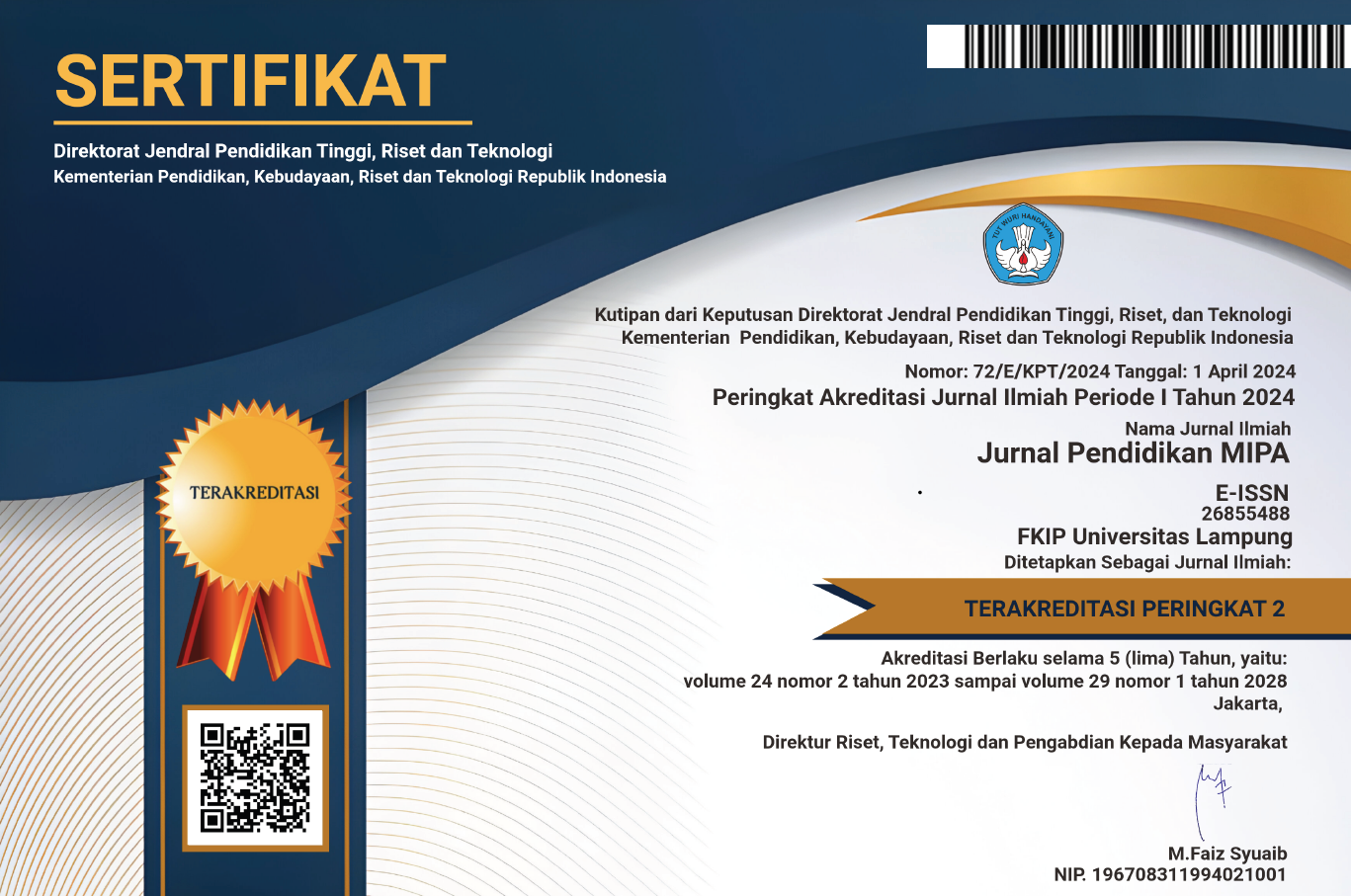Analysis of PISA Model Problems on Junior High School Mathematics Textbooks Published by Indonesia Ministry of Education in the 2017 Revised Edition
 Country:
Country:
(1) Universitas Bengkulu, Indonesia
(2) Universitas Bengkulu, Indonesia
(3) Universitas Bengkulu, Indonesia
(4) Universitas Bengkulu, Indonesia
This study aims to describe the problems of the PISA model in mathematics textbooks which are in terms of the aspects contained in the components of the PISA model. The research subjects were competency test questions in the 2017 revised edition of the 2017 curriculum 2013 math textbooks, totaling 180. This study used a descriptive method with a qualitative approach. The research instrument was an analysis guide sheet based on the aspects of content, context, and cognitive level of the PISA model questions. Data analysis uses the stages of unit purchasing analysis, categorizing, and coding. The results showed that there were 17.22% of the PISA model questions. The questions are distributed based on each content consisting of number, space & shape, change & relationship, and impossibility & data. In the context aspect, the questions only fulfill three contexts, personal work, and social judging from the level of cognitive questions that are applied at the level of remembering, understanding, applying, analyzing, and assessing levels.
Keywords: mathematics textbook, PISA model, junior high school.
DOI: http://dx.doi.org/10.23960/jpmipa/v24i1.pp213-224
Asaprawira, M. N. (2019). Developing mathematics questions of pisa type using bangka context. journal on mathematics education, 10(2), 303-314. https://doi.org/10.22342/jme.10.2.5366.303-314
Dewantara, A. H., Zulkardi, & Darmawijoyo. (2015). Assessing seventh graders’ mathematical literacy in solving PISA-like tasks. Journal on Mathematics Education, 6(2), 39-49.
Efriani, A., & Putri, R. I. I. (2019). Sailing context in pisa-like mathematics problems. Journal on Mathematics Education, 10(2), 265-276. https://doi.org/10.22342/jme.10.2.5245.265-276
Haji, S., Yumiati, & Zamzaili. (2018). Analisis kesulitan siswa dalam menyesaikan soal-soal pisa ( program for international student assessment ) di smp kota bengkulu. [analysis of students' difficulties in completing pisa (program for international student assessment) questions at smp kota bengkulu]. Jurnal Pendidikan Matematika Raflesia, 3(2), 177-183.
http://ejournal.unsri.ac.id/index.php/jpm/article/view/2161
Jannah, R. D., & Putri, R. I. I. (2019). Soft tennis and volleyball contexts in asian games for pisa-like mathematics problems. Journal on Mathematics Education, 10(1), 157170. https://doi.org/10.22342/jme.10.1.5248.157-170
Kolovou, A., Heuvel, M. V., Panhuizen, & Bakker, A. (2009). Non-routine problem solving tasks in primary school mathematics textbooks-a needle in a haystack. Mediterranean Journal For Research In Mathematics Education, 8(2), 31-68
Moleong, J. Lexy. (2011). Metodologi penelitian kualitatif [qualitative research methodology]. Bandung: Remaja Rosda karya
Munayati, Z,. Zulkardi,. & Santoso, B. (2015). Kajian soal buku teks matematika kelas x kurikulum 2013 menggunakan framework pisa [study of class x mathematics textbooks in the 2013 curriculum using the pisa framework]. Jurnal Pendidikan matematika, 9(2). Diakses dari:
OECD. (2015). PISA 2015 draft mathematics framework. New York: Columbia University
OECD. 2019. PISA 2018. PISA 2018 result combined executive summaries. PISAOECD Publishing
Pratiwi, I., Putri, R.I.I., & Zulkardi. (2019). Long jump in Asian Games: Contexts of PISA-Like mathematic problems
Prensel, M., Kobarg, M., Schöps, K., & Rönnebeck, S. (2013). Research on PISA: research outcomes of the PISA research conference 2009. New York, NY: Springer
Pusmendik-Kemendikbud. (2022). Asesmen kompetensi minimum. Pusat Asesmen Pendidikan Kemendikbudristek
Rastuti, M., & Prahmana, R. C. I. (2021). The programme for international student assessment research in Indonesia. Jurnal Elemen, 7(2), 232-253.
Schleicher, A. (2018). PISA 2018 (Insights and interpretations). OECD Publishing (5), XVII, 236 p.; 26x17 cm.
Stacey, K. (2011). The PISA view of mathematical literacy in indonesia. Journal on Mathematics Education, 2(2), 95-126. https://doi.org/10.22342/jme.2.2.746.95-126
Sudaryono, dkk. 2013. Pengembangan instrumen penelitian pendidikan [Development of Educational Research Instruments]. Yogyakarta: Graha Ilmu.
Suharyono, Rosnawati. (2020). Analisis buku teks pelajaran matematika smp ditinjau dari literasi matematika.
Susanta, A., Koto, I., & Susanto, E. (2022). Teachers' ability in writing mathematical literacy module based on local context. Education Quarterly 224
Susanta, A., Sumardi, H., Susanto, E., & Retnawati, H. (2023). Mathematics literacy task on number pattern using Bengkulu context for junior high school students. Journal on Mathematics Education, 14(1), 85–102. https://doi.org/10.22342/jme.v14i1.pp85-102
Susanta, A., Susanto, E., & Maizora, S. (2021, November). The level of junior high school students’ thinking in solving timss mathematical problems in bengkulu. In International Conference of Mathematics and Mathematics Education (I-CMME 2021) (pp. 9-13). Atlantis Press.
Usnul, U., Johar, R., & Sofyan, H. (2019). Potential effect of pisa equivalent questions using the context of aceh traditional houses. JRAMathEdu (Journal of Research and Advances in Mathematics Education), 4(2), 89-100. https://doi.org/10.23917/jramathedu.v4i2.8362
Zulkardi, Z., & Kohar, A. W. (2018). Designing PISA-like mathematics tasks in Indonesia: Experiences and challenges. In Journal of Physics: Conference Series (Vol. 947, No. 1, p. 012015). IOP Publishing.
Refbacks
- There are currently no refbacks.

This work is licensed under a Creative Commons Attribution-ShareAlike 4.0 International License.






